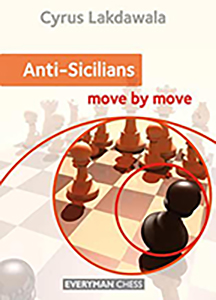Anti-Sicilian
Cyrus Lakdawala

Cyrus Lakdawala is unquestionably one of the most prolific writers on the game today. The workhorse for Everyman Chess, he has written close to 30 books for them in the past half a dozen years and shows no sign of slowing down. This sort of output understandably raises the question of whether the author is just going through the motions after having written over 10,000(!) pages on the royal game. Fear not. The latest offering by the San Diego International Master, Anti-Sicilian, features the clear explanation and humor that are his trademarks.
The Anti-Sicilians is hardly the first book to deal with Whites attempts to meet the Sicilian with anything but 2.Nf3 and 3.d4, but it is using the Everyman Chess move by move format. What this means for the reader is that instead of having the material arranged in standard opening book fashion it is organized in 51 well-annotated games. Each of these games is not only well-annotated, but also includes many exercises (usually 4 to 6 per game) designed to engage the reader.
Lakdalwala not only annotates the opening of each game, but also the middle and endgame. He also features a great deal of explanatory prose making these books especially valuable to class players (1400-2200). Of course this approach requires some trade offs. Although Lakdawala covers the opening thoroughly enough to satisfy players up to 2400, the move by move format does not allow for the depth that is the standard for Quality Chess publications.
The present work, which will satisfy all but professional players, offers the following repertoire:
2.c3 Sicilian (2…Nf6 followed by …b6). Note this varies if White opens 2.Nf3 Nc6 3.c3.
Rossolimo/Moscow Black goes for …d6 setups 4.0-0 Bd7.
Closed Sicilian 1.e4 c5 2.Nc3 Nc6 3.g3 g6 4.Bg2 Bg7 5.d3 Rb8.
Kings Indian Attack 1.e4 c5 2.Nf3 Nc6 3.d3 e6 4.g3 d5 5.Nbd2 Bd6 6.Bg2 Nge7 8.0-0 0-0.
Grand Prix 1.e4 c5 2.Nc3 Nc6 3.f4 g6 4.Nf3 Bg7 5.Bb5 Nd4 6.0-0 0-0.
Smith Morra 1.e4 c5 2.d4 cxd4 3.c3 dxc3 4.Nxc3 Nc6 5.Nf3 e6 6.Bc4 Nge7.
The lines offered are for the most part intended for a player opening 1.e4 c5 2.Nf3 Nc6 but there is supplemental material for those who play 2…d6 or 2…e6 to fill in the gaps.
Lakdawala generally goes for solid, well-tested lines that wont be refuted by one sharp move. A case in point in the Grand Prix variation reached after 1.e4 c5 2.Nc3 Nc6 3.f4 g6 4.Nf3 Bg7 5.Bc4 e6 6.f5 Nge7 7.fxe6 and now not the theoretical 7…fxe6 which might be best but leads to very messy positions (which he shows) but the very playable 7… dxe6.
Like all Everyman Chess books, the present work is not only available in print format but several electronic options including Kindle, ChessBase CBV and PGN.
Recommended.
